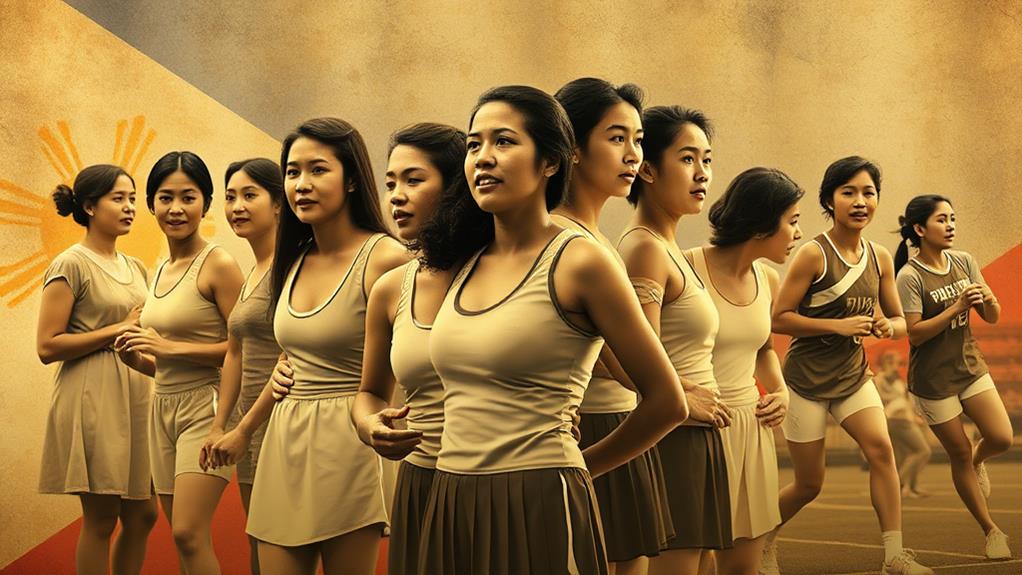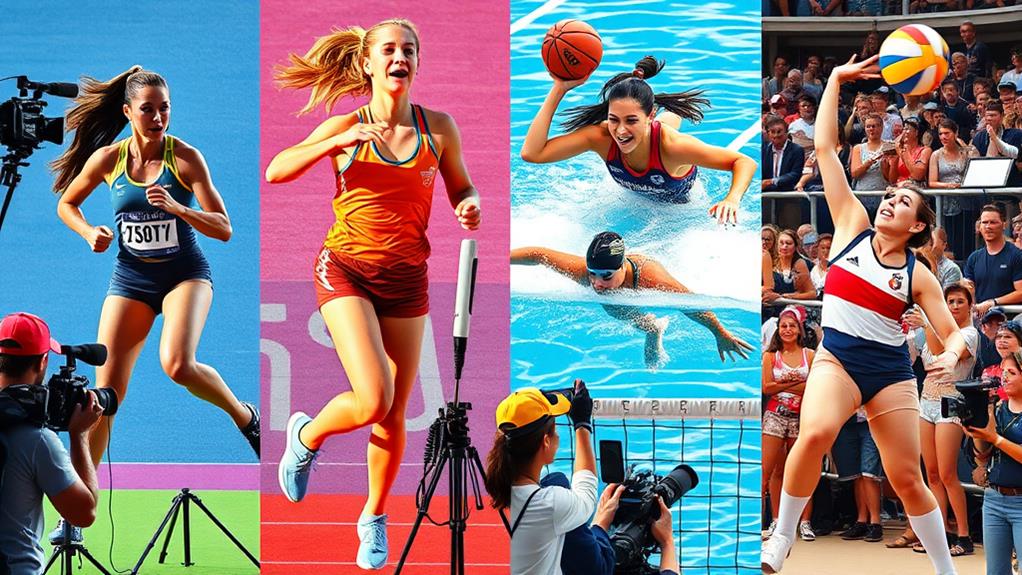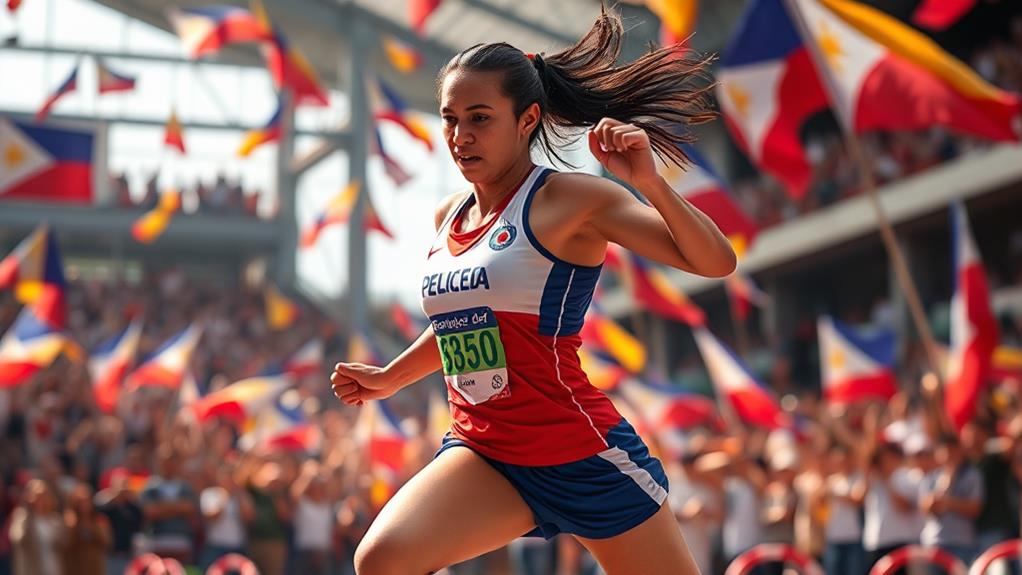Female athletes are gaining ground in the Philippines, transforming the sports scene in the country. This shift is evident in remarkable achievements, such as the Filipinas’ debut in the FIFA Women’s World Cup in 2023 and Hidilyn Diaz’s gold medal win at the Tokyo Olympics.
Today, women make up 40% of the national training pool, which has led to more opportunities opening up through professional leagues and grassroots initiatives.
Media coverage has boosted visibility and recognition, while continued advocacy for gender equality promotes inclusivity.
These trends indicate a bright future where female athletes are increasingly celebrated and supported as they chase their dreams.
Historical Context of Female Athletes

Women’s Participation in Sports in the Philippines Has Evolved Significantly
Women’s involvement in sports in the Philippines has undergone significant changes, reflecting broader societal shifts. In the late 19th century, women athletes began to emerge, often facing criticism for participating in organized sports.
Women’s colleges organized early competitions, laying the groundwork for future opportunities.
A Major Milestone in the Olympics
Teofista “Tita” De Guzman became the first female athlete to compete in the Olympics for the Philippines in 1932. This milestone marked a significant step forward for women in sports.
Establishment of the Philippine Women’s Basketball League
The Philippine Women’s Basketball League was established in the 1970s, providing a structured platform for female athletes.
Despite facing gender inequality and limited visibility compared to men’s leagues, women continued to persevere.
Rise of Elite Players and Growing Recognition
Hidilyn Diaz secured the country’s first Olympic gold medal in weightlifting at the Tokyo 2020 Games, significantly raising the profile of women in sports.
The Filipinas made their debut in the FIFA Women’s World Cup in 2023, showcasing the growing recognition and opportunities for women in athletics.
Resilience and Determination
The historical context highlights the resilience and determination of women athletes in the Philippines, paving the way for future generations to thrive.
Current Trends in Women’s Sports
Women’s sports in the Philippines are undergoing a significant transformation. Recent developments indicate a dynamic shift in both participation and recognition.
Female athletes now make up a substantial portion of the national training pool. In fact, they comprise 40% of the national training pool, highlighting the increased participation of women in sports.
The Philippines has made history in international women’s football. The Filipinas competed in the 2023 FIFA Women’s World Cup, finishing 24th out of 32 teams, showcasing the growth of women’s football in the country.
Financial investments in women’s sports are on the rise. The 2023 Women’s Premier League in India raised US$580 million, inspiring similar developments locally. This increase in investment is expected to have a positive impact on the growth of women’s sports in the Philippines.
Efforts to establish professional leagues for women’s basketball continue despite challenges. Despite funding challenges and limited roster options, efforts are being made to establish professional leagues for sustainability and opportunity.
Historical achievements have contributed to the increased visibility and support for female athletes. Hidilyn Diaz’s Olympic gold medal is a prime example of this, paving the way for continued growth and recognition of women’s sports in the Philippines.
Media Coverage and Visibility

Media Coverage and Visibility
Increased Recognition through Media Coverage
The shift in women’s sports in the Philippines is marked by growing recognition of female athletes through enhanced media coverage.
Historically, media attention was limited, but it’s finally shifting. The establishment of professional leagues like the Premier Volleyball League in 2021 has significantly increased exposure for female athletes and their accomplishments.
Landmark Events and Visibility
The 2023 FIFA Women’s World Cup, where the Philippines made its debut, attracted considerable media attention and showcased the potential for broader visibility.
Despite challenges, the push for professionalization is vital for ongoing engagement and support.
Local Initiatives and Community Programs
Local initiatives and community programs play a crucial role in promoting female athletes, fostering inclusivity, and breaking down traditional barriers to visibility.
As seen in the attendance figures during the 2023 World Cup, which welcomed 1.9 million fans, there’s a growing interest in women’s sports. By capitalizing on this momentum, we can help elevate female athletes and their contributions to sports in the Philippines.
Challenges Faced by Female Athletes
Female athletes in the Philippines face significant barriers to their progress and representation in sports. Despite making up 40% of the national training pool, they encounter challenges that hinder their participation and success.
Limited access to organized sports is a major obstacle. In the Philippines, organized sports are often restricted to affluent families, making it difficult for girls from lower-income backgrounds to participate. This limitation is a significant factor in the underrepresentation of female athletes.
The coaching pool lacks female representation. Only 17% of coaches are women, which limits mentorship opportunities for female athletes. This shortage of female coaches contributes to the lack of role models and support for aspiring female athletes.
Grassroots sports programs are inadequate. There’s insufficient support for grassroots sports programs, particularly for girls from lower-income backgrounds. This lack of support hinders the development of aspiring female athletes and widens the gap between male and female athletes.
Cultural norms and patriarchal mindsets discourage girls from participating in sports. Societal attitudes often view sports as a male domain, discouraging girls from participating. This mindset must change to create a more inclusive sports environment.
The lack of female sports role models has a ripple effect. The scarcity of female role models in sports makes it harder for young girls to envision themselves in athletic careers. This cycle of underrepresentation perpetuates the gender gap in sports.
National sports associations must provide greater support for women’s events. The insufficient support for women’s events highlights the gaps that still exist. Addressing these challenges is crucial for the development and empowerment of female athletes, creating a more inclusive sports environment where they can thrive and succeed.
How Have Female Athletes in the Philippines Contributed to Breaking Down Gender Barriers in Sports?
Female athletes in the Philippines have been instrumental in breaking down sports and gender equality barriers. Through their dedication and talent, they have shattered stereotypes and inspired young girls to pursue their athletic dreams. Their success has helped pave the way for a more inclusive and equal playing field in sports.
Impact of Major Events

Major sporting events have significantly impacted women’s sports in the Philippines.
The country’s historic participation in the 2023 FIFA Women’s World Cup, where they finished 24th out of 32 teams, showcases the nation’s commitment to fostering female athletes. This milestone reflects a growing interest in women’s football and amplifies the visibility of female athletes in the country.
Major events inspire a new generation of athletes.
Hidilyn Diaz’s triumph at the Tokyo Olympics in 2021, where she secured the Philippines’ first Olympic gold medal, inspired a new generation of athletes participating in various sports.
The 2018 Asian Games, where female athletes contributed to 70% of the total medal count, further underscores the importance of major events in elevating women’s sports visibility and performance.
Investment in women’s sports is on the rise.
The recent success of leagues like India’s Women’s Premier League indicates a shift toward gender parity.
These major events not only celebrate female athletes but also pave the way for more opportunities, inspiring future competitions and fostering a supportive environment for women’s sports in the Philippines.
Future Prospects for Women’s Sports
The future of women’s sports in the Philippines looks promising. The historic qualification of the Philippine Women’s National Football Team for the 2023 FIFA Women’s World Cup is a testament to the growing recognition of female athletes on a global scale.
Moreover, the increasing representation of female athletes in the national training pool, which now stands at 40%, demonstrates the rising support for women’s participation in elite sports.
Professionalization of leagues enhances competitiveness and visibility. The Premier Volleyball League (PVL) is a prime example of a professional league that promotes competitiveness and visibility for female athletes.
This platform provides opportunities for women to showcase their skills, gain recognition, and inspire others to follow in their footsteps.
Community initiatives expand access and opportunities for girls in sports. Programs like Girls Got Game are instrumental in introducing girls to various sports, providing them with the necessary skills and confidence to pursue their athletic interests.
These initiatives help bridge the gap between interest and participation, ultimately increasing the number of female athletes in the country.
Advocacy for gender equality is crucial for dismantling barriers. Efforts to promote gender equality create a supportive environment that allows female athletes to thrive.
By addressing the existing barriers, women’s sports can become more inclusive, and female athletes can focus on their training and development without unnecessary obstacles.
A growing focus on talent development ensures guidance for aspiring female athletes. The emphasis on talent development programs provides aspiring female athletes with the necessary guidance, training, and resources to excel in their chosen sports.
This focus enables them to reach their full potential, compete at higher levels, and become role models for future generations.
The future of women’s sports holds great potential. As these elements come together, they create an ecosystem that nurtures participation in women’s sports.
With increased opportunities and ongoing advocacy, female athletes can shine both locally and internationally, inspiring others to follow in their footsteps.
Questions and Answers
When Did Female Athletes Start?
Female athletes began making their mark in the early 1900s. During this time, grassroots programs and early competitions were established, paving the way for women’s sports.
Despite cultural barriers, pioneering athletes gained government support, which helped improve their media representation over the years.
A major milestone was the 1970 Women’s National Basketball Championship, which showcased female athletes’ talent and capabilities. Their participation in international events further solidified their reputation.
Today, these trailblazing athletes serve as role models, inspiring future generations to pursue sports and break boundaries.
Is Women’s Sport on the Rise?
Women’s sport is on the rise. This growth is driven by grassroots development programs that increase youth engagement and provide opportunities for young girls to participate in sports. For example, the Girls on the Run program has reached over 185,000 girls in the United States and Canada, teaching them valuable life skills and promoting physical activity.
Media representation plays a significant role in shaping public perception and promoting women’s sports. The increased coverage of women’s sports events, such as the Women’s World Cup and the WNBA, has helped to raise their profile and attract new fans.
Additionally, sponsorship opportunities are increasing, with brands like Nike and Adidas investing heavily in women’s sports. This investment not only provides financial support but also helps to raise the visibility of women’s sports.
Role models are breaking down social barriers and inspiring young girls to participate in sports. Athletes like Serena Williams, Simone Biles, and Megan Rapinoe are using their platforms to promote gender equality and challenge traditional gender stereotypes.
As a result, community support initiatives are flourishing, with organizations like the Women’s Sports Foundation providing resources and support to female athletes.
Awareness of health benefits is driving participation. Studies have shown that regular physical activity can reduce the risk of chronic diseases, improve mental health, and boost self-esteem.
As a result, athletic competition equality is becoming a priority, with many schools and organizations working to provide equal opportunities for girls and women to participate in sports.
Who Is the Famous Female Runner in the Philippines?
If you’re looking for a famous female runner in the Philippines, Lydia de Vega is a notable example.
She’s a renowned track and field athlete who’s won numerous awards and has been recognized for her achievements.
De Vega excelled in sprinting events, particularly in the 100-meter dash, and has inspired many young athletes in the Philippines.
Why Is Women’s Representation Important in Sports?
Women’s representation in sports is crucial for promoting gender equality and breaking cultural barriers.
Seeing female athletes as role models inspires youth participation and encourages girls to pursue sports. For instance, the popularity of the US Women’s National Soccer Team has led to a significant increase in girls’ participation in soccer.
Increased media coverage and sponsorship opportunities enhance visibility.
Media outlets like ESPN and Fox Sports have committed to broadcasting more women’s sports events, providing greater exposure for female athletes.
Additionally, brands like Nike and Adidas have launched campaigns specifically targeting women in sports, offering more sponsorship opportunities.
Athletic achievements demonstrate women’s capabilities.
Female athletes have broken records and won championships in various sports, showcasing their skills and abilities.
For example, Serena Williams has won 23 Grand Slam singles titles, proving herself to be one of the greatest tennis players of all time.
Engaging in sports fosters leadership skills and community support, and offers health benefits.
Participating in sports helps girls develop leadership skills, build confidence, and establish strong relationships with their teammates.
Furthermore, regular physical activity reduces the risk of chronic diseases and improves overall health.
Ultimately, women’s representation in sports contributes to a more equitable and empowered society.